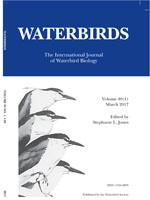Methylmercury biomagnifies in food chains and can lower reproductive success in many organisms, particularly in top predators such as Brown Pelicans (Pelecanus occidentalis). To determine and compare variability in mercury exposure in this species, chick feathers and egg membranes were collected from seven breeding sites located in the remote Pamlico Sound and the more human-impacted Cape Fear River in North Carolina, USA. The average concentration of total mercury in egg membrane was 0.20 ± 0.14 ppm dry weight, a level associated with slightly reduced reproductive success in some birds, while chick feather total mercury concentrations (1.13 ± 0.02 ppm fresh weight) were well below the lowest observable adverse effects level. Mercury exposure did not vary between the Cape Fear River and Pamlico Sound, but did vary significantly among three Cape Fear River colonies. Diet analysis using δ13C and δ15N revealed minimal differences in the trophic level and foraging location of prey between islands in close proximity, indicating that differences in mercury availability are not due to differences in diet composition. The source of mercury variation in Brown Pelicans remains unknown and in need of further study.
How to translate text using browser tools
1 March 2017
Mercury Exposure and Diet in Brown Pelicans (Pelecanus occidentalis) in North Carolina, USA
Kiersten N. Newtoff,
Steven D. Emslie
ACCESS THE FULL ARTICLE

Waterbirds
Vol. 40 • No. 1
March 2017
Vol. 40 • No. 1
March 2017
Biomagnification
Brown Pelican
carbon
methylmercury
nitrogen
Pelecanus occidentalis
stable isotopes




